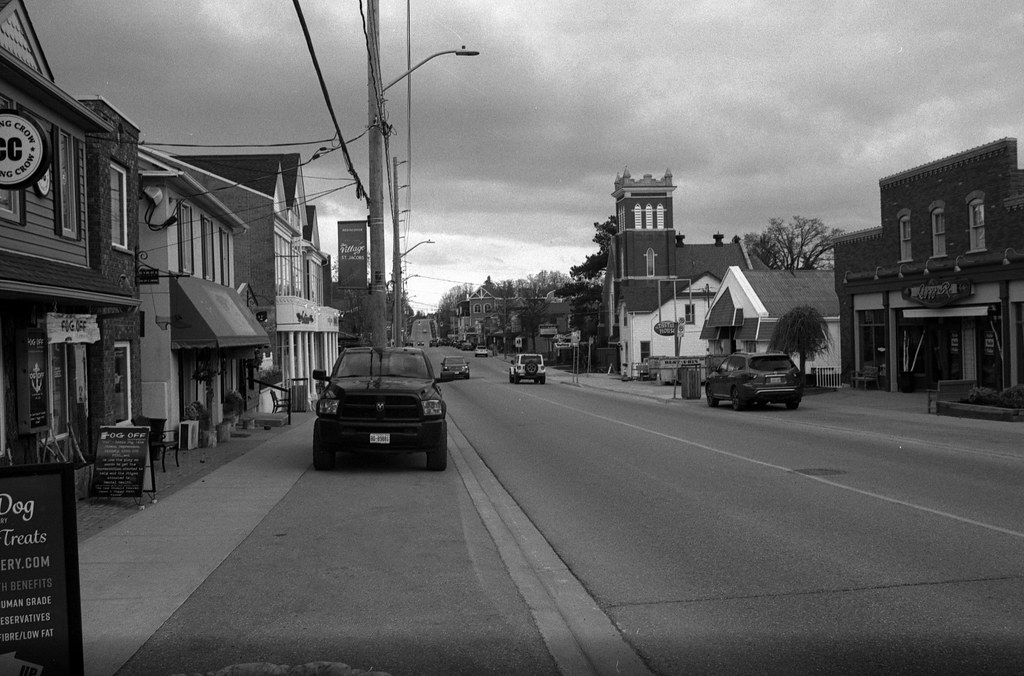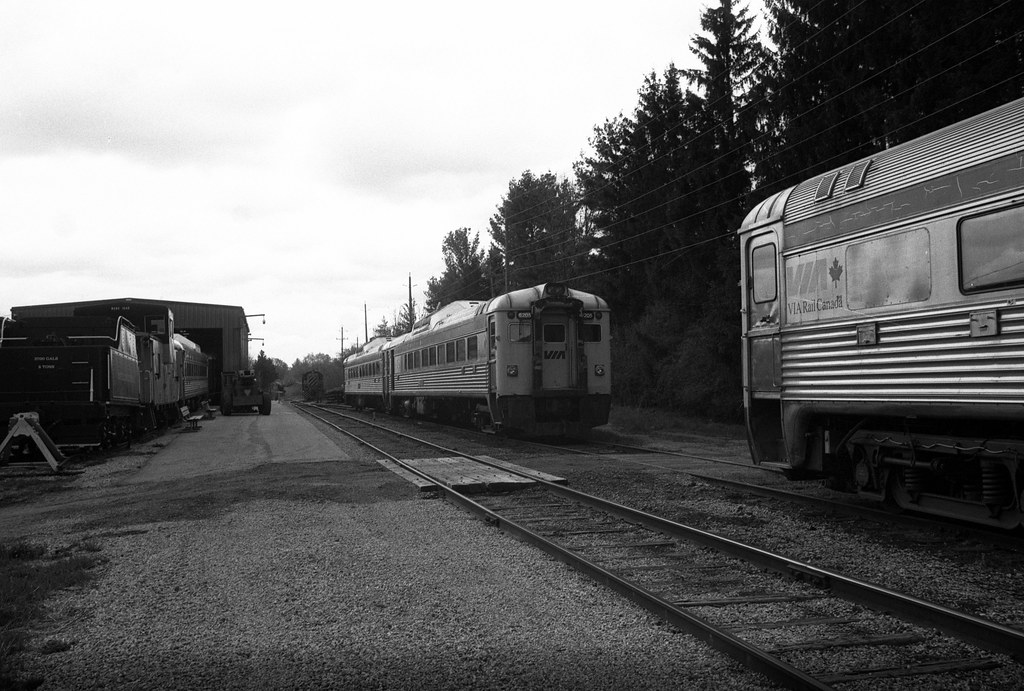Two weeks in a row outside of Halton Region? Yes, the continuing lockdown has made me go stir-crazy, and you can honestly only find so much to photograph within your own little part of Ontario. Plus, I have to keep a few ideas in the back pocket as backups if something big prevents me from getting out. After doing plenty of these types of projects, you need some ideas as backups. But this week, we’re back into rural Ontario and the community of St. Jacobs, home to an amazing farmer’s market, a tourist railroad, Mennonites, and a cute little downtown. While I would have liked to include the farmers market, I didn’t want to go in for the sole reason of photography and take a spot from a person who is there to buy fresh farm produce.

Nikon FM – AI-S Nikkor 35mm 1:2.8 – Fomapan 100 @ ASA-100 – Rollei Supergrain (1+15) 7:30 @ 20C
The earliest European settlement of the region started in the 1830s, with two culturally distinct settlements founded along the Conestogo River. Conestogo would be settled primarily by Germanic descent, while Winterbourne was primarily Anglo (English and Scottish). The first families in Conestogo were Simon Cress, Abraham Erb and John Bauman. By 1844, Valentine Ratz built the first sawmill, and a single-room log cabin school also sprung up. Settlement ramped up by the mid-century, with most being Mennonites from Pennsylvania, better known as Pennsylvania Dutch. Dutch in the sense of a mispronunciation of Deutsch or German. Jacob Snider would build a dam and sawmill in 1852, which only brought more settlers to the village, allowing it to be incorporated under the name Jakobsettle or Jacob’s Village, the St was added to make it better sounding, and pluralisation to indicate the efforts of Jacob Snider and his son Jacob Jr. By 1855 the village population topped at 400 with four hotels, a blacksmith, several mills, an Evangelical Association Church, and a general store. Electricity was introduced in 1871 by E.W.B. Snider, who used a hydroelectric generator to power his flour mill, but he also supplied power to a woollen factory and tannery. The first railroad arrived in 1891, but the village population remained fairly static at 500 people. Henry Gilles had purchased a tinsmith shop in 1880, which he quickly expanded to include a blacksmith and hardware store. Henry Sittler took over the management of the hardware store in 1933, even when the business was sold to Gordon Hollinger. Under Hollinger, a wholesale division was added to the hardware store. By 1938, Walter J. Hachborn began working for Hollinger, being fluent in English and Low German, which helped with many of the Mennonite customers. Sittler and Hachborn proved to be excellent partners and purchased Hollinger Hardware in 1949; the business grew rapidly. And both men realised that independent hardware store owners would benefit from a central wholesale organization. Initially, twenty-five owners joined the concept forming Hollinger Hardware Ltd in 1963. Which today, we know as Home Hardware with 1,100 stores by 2017.

Nikon FM – AI-S Nikkor 35mm 1:2.8 – Fomapan 100 @ ASA-100 – Rollei Supergrain (1+15) 7:30 @ 20C
Nikon FM – AI-S Nikkor 35mm 1:2.8 – Fomapan 100 @ ASA-100 – Rollei Supergrain (1+15) 7:30 @ 20C
I had a bit more of a difficult time picking out the images for the post today. There are several images that I wish I had thought a bit more about and got a better composition, and others that I wanted to include but did not add to the narrative. It’s a hard thing to pick only seven from a selection of twenty-four keepers from the roll. Despite this, I’m rather happy with the images I did get this week. For the featured image, I went with a long shot of the downtown, looking north along the main street at Hachborn. Two obvious choices is a shot from the Waterloo Central Railway, a local tourist train and a museum. Sadly I did not get a better shot of the railway’s diesel locomotive fleet, and their steam locomotive was in the shop and out of bounds. I also had to include a shot of the Sneider Flour Mill, part of the town silos, and a historical aspect of the community as one of the earliest businesses in the village. And, of course, a good detail shot of a tractor grill found nearby. One of the final images is of a unique downtown building with a full stone first floor then brick on the upper storey and stood out as unique among the downtown. The final image is of the Conestogo River with the Main Street Bridge and storm clouds starting to gather, indicating it was time to head out.

Nikon FM – AI-S Nikkor 35mm 1:2.8 – Fomapan 100 @ ASA-100 – Rollei Supergrain (1+15) 7:30 @ 20C
Nikon FM – AI-S Nikkor 35mm 1:2.8 – Fomapan 100 @ ASA-100 – Rollei Supergrain (1+15) 7:30 @ 20C
Despite the overcast weather and the constant threat of rain, I shot this week’s roll of Fomapan 100 at the box speed of ASA-100, and while I wasn’t getting deep depth of fields, shooting mostly between f/4 and f/8, using a 35mm lens offered up a decent happy medium to capture the downtown and the historic rail museum. Although in some cases, I did wish I had brought the 50mm and 135mm lenses with me to get some more detailed shots in the railway museum and some nature shots by the river. Overall, the 35mm f/2.8 was the better choice, and it allowed me to keep walking and not stop and fumble all the time. For the developer, I went again with Rollei Supergrain using the same time and dilution as last week as I enjoyed those results. There was certainly no need for the yellow filter, and it might have been detrimental to getting good images with the dull light.

Nikon FM – AI-S Nikkor 35mm 1:2.8 – Fomapan 100 @ ASA-100 – Rollei Supergrain (1+15) 7:30 @ 20C
Nikon FM – AI-S Nikkor 35mm 1:2.8 – Fomapan 100 @ ASA-100 – Rollei Supergrain (1+15) 7:30 @ 20C
Next week we’re heading out to Uxbridge and discovering not only a pretty historic town but also a deep tragedy.